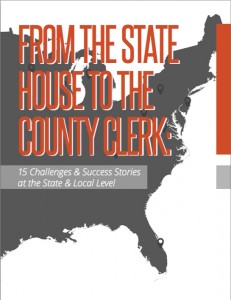 Transparency is a critical issue for governments, but figuring out ways to display complex financial data can be cumbersome. One solution is to create a real-time financial dashboard. Ari Hoffnung, Senior Adviser, is the former Deputy Comptroller for New York City and one of the founders of Checkbook NYC, a financial transparency application widely considered one of the best in the country.
Transparency is a critical issue for governments, but figuring out ways to display complex financial data can be cumbersome. One solution is to create a real-time financial dashboard. Ari Hoffnung, Senior Adviser, is the former Deputy Comptroller for New York City and one of the founders of Checkbook NYC, a financial transparency application widely considered one of the best in the country.
Checkbook NYC provides unprecedented access to track how the government of New York City spends its $70 billion+ annual budget. Hoffnung was featured in GovLoop’s From the State House to the County Clerk – 15 Challenges and Success Stories Guide. Here is a small excerpt from the guide:
Why is financial transparency so critical for state and local governments?
Hoffnung: Taxpayers want to know exactly how their hard-earned money is being spent. A 2011 Gallup poll found that Americans believe that state governments waste 42 cents on the dollar and local governments waste 38 cents on the dollar. I understand the sentiment that government is wasteful and I don’t think anybody that’s worked in government would argue that there’s absolutely no waste.
With that said, I also don’t think that anybody who’s worked in the private sector would claim to have seen no waste. But the fact that so many folks believe that nearly 50 percent of government spending is wasteful is very alarming and points to a deep mistrust between the public and government.
I attribute this mistrust to the fact that too few people understand how government spends their money. To me, financial transparency is a great way to address this disconnect and to restore the trust between government and the public. Governments ought to provide taxpayers with an easy way to see how their hard-earned money is being spent.
How hard is it to show the results of strong financial transparency?
Hoffnung: Some savings – like those stemming from government employees spending less time on FOIA requests – can be quantified without too much trouble. Other costs savings are a bit more challenging to quantify.
In my opinion, the largest cost savings from financial transparency are those that result from human psychology. When people like government officials or contractors know that their financial decisions will be placed in the public domain to review, they make better decisions.
While it’s nearly impossible to quantify the cost savings that come from a government making fewer poor decisions, since that would require you to quantify what didn’t happen, the savings could still be estimated.
Can you help us to do that? How would a city government ballpark the cost savings from investing in financial transparency?
Let’s take a city like Boston that recently deployed Socrata’s Open Budget application. Boston’s budget is approximately $3 billion. Imagine if they were able to save one percent of their budget by making better decisions. One percent of $3 billion would be $30 million; that’s a lot of money. If somehow that sounds too high, let’s say they were able to save 0.1 percent by making better decisions. That’s still $3 million. I think that most people would agree that government could save 0.1 percent of their budget by investing in financial transparency.
What is the best way for state and local governments to reveal financial information to the public?
Hoffnung: Dashboards are one of the most effective ways. I was privileged to spearhead the Big Apple’s Checkbook NYC project. We took over $70 billion of annual spending, and put it online so that every day taxpayers could see how their hard earned money is being spent.
When you could logon to a user-friendly website to see how government spends money you are less likely to think your tax dollars are being thrown down a big black hole.
What would you like to see governments do next with financial transparency?
Hoffnung: One of the reasons I joined Socrata is because I wanted to see other state and local governments adopt financial transparency, websites and applications. It’s really important that governments across this country have the tools to share their information online. It cost NYC $3 million to build Checkbook NYC. Now, at a fraction of that cost, you can have something very similar with Socrata’s suite of financial transparency applications. Governments of every size could now leverage best practices and offer their taxpayers full financial transparency at an affordable cost.
Besides building trust with the public, why is financial transparency important?
Hoffnung: In addition to strengthening democracy, financial transparency saves taxpayer money. For example, the state of Massachusetts reported that by posting state contracts online, bids for transportation projects came in 15 [percent] to 20 percent below the state’s initial bid. There are many other examples like this. Having been actively involved in financial transparency initiatives for nearly five years I am convinced that it one of the best possible investments for a government.
To learn more about download the guide, From the State House to the County Clerk – 15 Challenges and Success Stories.






Leave a Reply
You must be logged in to post a comment.